Abstract
Irreversible chemical programming of monoclonal aldolase antibody (mAb) 38C2 has been accomplished with β-lactam equipped targeting modules. A model study was first performed with β-lactam conjugated to biotin. This conjugate efficiently and selectively modified the catalytic site lysine (LysH93) of mAb 38C2. We then conjugated a β-lactam to a cyclic-RGD peptide to chemically program mAb 38C2 to target integrin receptors αvβ3 and αvβ5. The chemically programmed antibody bound specifically to the isolated integrin receptor proteins as well as the integrins expressed on human melanoma cells. This approach provides an efficient and versatile solution to irreversible chemical programming of aldolase antibodies.
Monoclonal antibody (mAb) 38C2 was generated by reactive immunization with a 1,3-diketone hapten.1 This antibody possesses a lysine residue at position 93 of the heavy chain, LysH93, that has an unusually low pKa of ~6.0 and is essential for the catalytic mechanism of the antibody.2 mAb 38C2 can be chemically programmed to selectively bind to cells or other targets by selective reaction of LysH93 with β-diketone (Scheme 1A) or an acetone aldol adduct of a vinylketone (Scheme 1B) linker equipped with a targeting ligand or module.3-8 Many of our studies have used antagonists of αvβ3 and αvβ5 integrins as targeting modules for chemical programming of aldolase antibody specificity.3-7 In the first case, a reversible covalent attachment of a diketone compound is achieved through the formation of an imine, which isomerizes to the more stable enaminone derivative. In the latter case, an acetone aldol adduct of the vinylketone is used as a prolinker, because the vinylketone linker is highly reactive. mAb 38C2 catalyzes the retro-aldol reaction of the prolinker to give free vinylketone linker, which then undergoes Michael addition, in situ, with the catalytic Lys residue in the antibody binding site. This approach provides irreversible attachment of the targeting modules; however, preparation of the prolinker equipped targeting modules requires complicated multistep synthesis and is not compatible with a wide range of substrates.
Scheme 1.
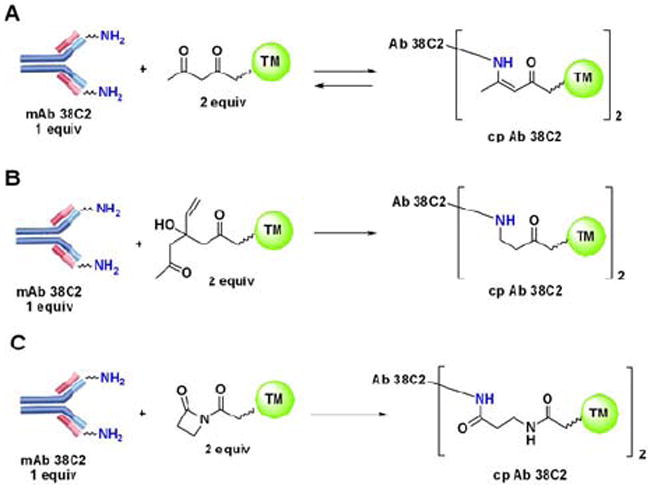
Different approaches for the chemical programming of mAb 38C2 using a reactive moiety linked to a targeting module (TM).
In earlier studies we had explored a β-lactam based modification strategy for covalent attachment of thiazolium cofactor into the active site of aldolase antibodies in order to prepare the first thiazolium-dependent catalytic antibodies.9 Given the success of this study and the chemical stability of the resulting covalent modification, we were encouraged to examine this approach as a route to chemically programmed antibodies. We now report the selective reaction of the catalytic site LysH93 with β-lactam-equipped targeting modules (Scheme 1C); the synthesis of the targeting module was straightforward and this strategy provides for irreversible covalent attachment of targeting modules. We designed our linker molecules with three features in mind: First, 1-acyl β-lactams react efficiently with LysH93.9 Second, the narrow and highly lipophilic catalytic site of mAb 38C2 should bind tightly to a phenyl ring based on the crystal structure of the antibody.2 Third, given the disposition of LysH93 at the bottom of the 11Å deep active site, a linker of appropriate length should be incorporated to allow functional display of the targeting module outside the active site of the antibody.
The heterobifunctional β-lactam targeting module 3 was synthesized in six steps starting from inexpensive starting materials. In brief, 2-(2-(2-chloroethoxy)ethoxy)ethanol 1 was treated with sodium azide in DMF to afford the corresponding azido alcohol in 89% yield (Scheme 2). Subsequent tosylation provided tosyl azide 2 in quantitative yield. Reaction of 2 with ethyl 4-hydroxybenzoate in the presence of potassium carbonate in DMF provided azido ester in 76% isolated yield. The ester was hydrolized using lithium hydroxide followed by a reaction with neat thionyl chloride to give the corresponding acid chloride. The crude acid chloride was used immediately for the reaction with 2-azetidinone in the presence of n-butyl lithium to afford the desired heterobifunctional module 3 in 44% isolated yield.
Scheme 2.
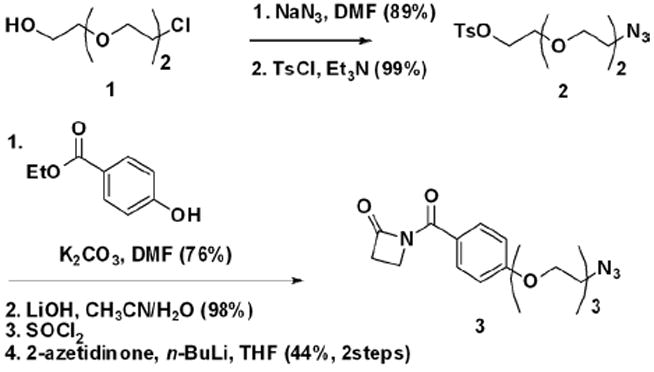
Synthesis of the heterobifunctional linker module 3.
We selected biotin as a model targeting module to evaluate the β-lactam-based approach for chemical programming of mAb 38C2. Biotin containing 6 was prepared as follows. Biotin N-hydroxysuccinimide ester 4 was coupled with propargyl amine to give alkynyl biotin 5 in 96% yield (Scheme 3).
Scheme 3.
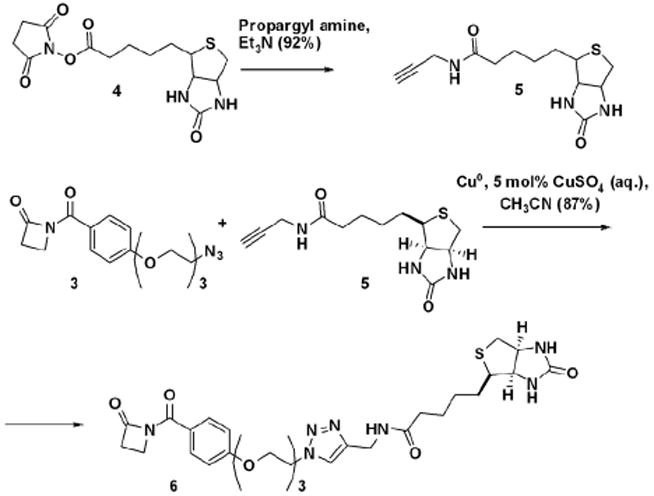
Synthesis of the β-lactam-biotin conjugate 6.
The subsequent copper (I)-catalyzed azide alkyne cycloaddition reaction10-15 of β-lactam module 3 and alkyne 5 furnished the desired targeting module 6 in 87% isolated yield.
Chemical programming of the mAb 38C2 with 6 was performed essentially as described.3 Only 2 equivalents of the targeting module 6 were used (1 equivalent per active site) and complete loss of catalytic activity of mAb 38C2 was observed after 2 hours at room temperature. Catalytic activity was measured by analysis of the retro-aldol reaction of methodol (Figure 1A).3 Aliquots were removed at different timepoints and the reaction was quenched by immediate removal of any unbound small molecules by desalting using Zeba spin desalting columns; the resulting purified antibody was tested in the methodol-based catalytic activity assay. Tryptic digest and subsequent MALDI-TOF analysis of the biotin programmed mAb 38C2 compared to that of mAb 38C2 gave an additional proof of the selective functionalization of catalytic site LysH93 in the context of the IgG (Figure 1B).9 To confirm that the chemically programmed antibody displayed biotin in a manner to allow for its binding to streptavidin, we also used a streptavidin ELISA (Figure 1C). We then chemically programmed the antibody to recognize integrin receptors αvβ3 and αvβ5 in order to explore the compatability of the β-lactam linker strategy with a substantially more functionalized targeting module. Heterobifunctional linker 9 containing azide and NHS functionalities was prepared starting from triethyleneglycol 7 (Scheme 4).
Figure 1.
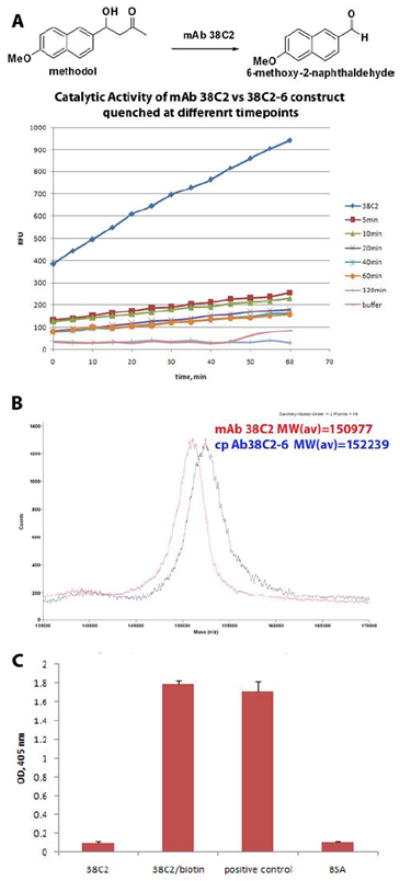
Analysis of the formation of mAb 38C2 chemically programmed with 6 (cp38C2-6). (A) The methodol-based catalytic activity assay of aliquots removed and quenched by desalting at indicated timepoints. (B) Overlay of MALDI-TOF analysis of mAb 38C2 and cp38C2-6. (C) Results of the ELISA assay showing streptavidin-HRPO binding of mAb 38C2 alone, cp38C2-6, commercially available biotinylated mouse Ab (positive control), and BSA.
Scheme 4.

Synthesis of the azido-functionalized cyclic-RGD module 10.
Triethylene glycol was bis-tosylated and converted to the corresponding bis-azide in excellent yield. The bis-azide was selectively reduced using an established procedure to give amino azide 8.16 Reaction of 8 with succinic anhydride and subsequent coupling with N-hydroxysuccinimide provided the desired heterobifinctional linker 9. Linker 9 was selectively conjugated with the ε-amino group of the lysine moiety in the cyclic-RGD peptide (cyclo(Arg-Gly-Asp-D-Phe-Lys)) to give module 10. We also prepared linker module 12 (Scheme 5) in order to introduce the β-lactam functionality into our integrin targeting module. Triethylene glycol 7 was treated with propargyl bromide in the presence of sodium hydride to afford a mixture of mono- and bis-propargylated products that were separated by column chromatography. Mono-propargylated alcohol was then tosylated to afford tosyl alkyne 11. Compound 11 was reacted with ethyl 4-hydroxybenzoate in the presence of potassium carbonate in DMF to afford the alkynyl ester in 98% yield without need for purification. The ester was hydrolized using lithium hydroxide and converted to the acid chloride by treatment with neat thionyl chloride. The crude acid chloride was used immediately for the reaction with 2-azetidinone in the presence of n-butyl lithium to afford the desired heterobifunctional linker 12 in 51% isolated yield.
Scheme 5.
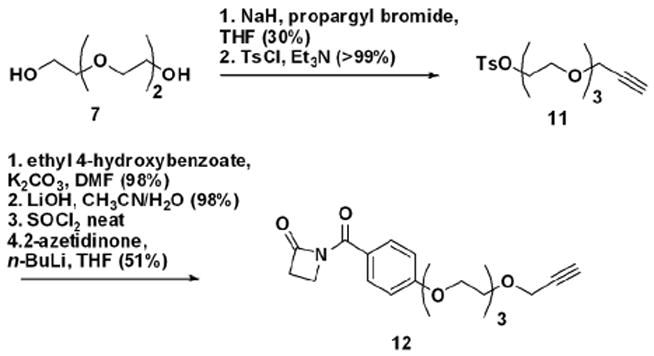
Synthesis of the heterobifunctional linker module 12.
The integrin targeting module 13 was synthesized in a copper (I)-catalyzed azide alkyne cycloaddition reaction of the heterobifunctional module 12 with the azido targeting module 10 (Scheme 6). The resulting β-lactam-equipped targeting module was incubated with mAb 38C2 to provide chemically programmed (cp) antibody. Binding of the cp38C2 to human integrins αvβ3 and αvβ5 was confirmed by ELISA assay (Figure 2A and B).3,7 Importantly, the chemically programmed antibody recognized the integrins on living cells: cp38C2 bound to human melanoma M21 cells that express both integrins αvβ3 and αvβ5 on their surface (Figure 2C).7 As expected, unprogrammed catalytic antibody 38C2 did not bind to M21 cells.
Scheme 6.
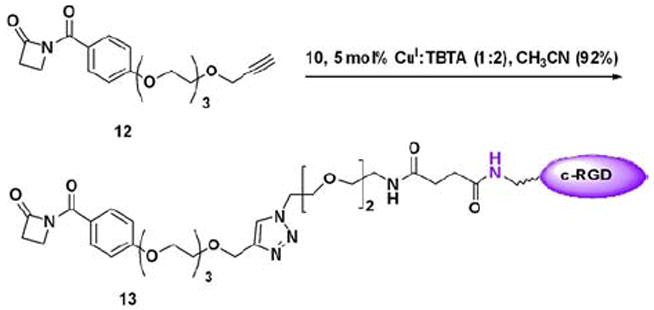
Synthesis of the β-lactam equipped cyclic-RGD conjugate 13.
Figure 2.

cp38C2 binds to integrins αvβ3 and αvβ5 (Chemicon). (A) ELISA demonstrating binding preferential binding of cp38C2 (38C2/RGD) to integrin αvβ3. Controls were unprogrammed mAb 38C2, antibody specific for the integrin αvβ3 (LM609) and BSA as a negative control antigen. (B) ELISA demonstrating binding preferential binding of cp38C2 to αvβ5. Here the integrin αvβ5-specific antibody P1F6 was used as a positive control (C) Analysis of cp38C2 binding to human melanoma M21 cells. Autofluorescence of M21 cells is represented as purple line; cells were stained with cp38C2 (red line), unprogrammed mAb 38C2 (green line), LM609 antibody (blue line) that acts as a positive control, and secondary antibody alone (orange line). Bound antibodies were detected with Cy5 conjugated donkey anti-mouse IgG
In conclusion, we have prepared β-lactam-equipped targeting modules and demonstrated that these modules can be used to prepare chemically programmed antibodies. The modular strategy and use of bioorthogonal click chemistry for the preparation of β-lactam-equipped targeting modules allowed straightforward access to these valuable immunotherapeutics. Further studies of the therapeutic effect of targeting integrin αvβ3 and αvβ5 receptors with chemically programmed mAb 38C2 are underway and will be reported in the due course.
Acknowledgments
This work was supported by Grant RO1 CA104045 from the National Institutes of Health.
Footnotes
Publisher's Disclaimer: This is a PDF file of an unedited manuscript that has been accepted for publication. As a service to our customers we are providing this early version of the manuscript. The manuscript will undergo copyediting, typesetting, and review of the resulting proof before it is published in its final citable form. Please note that during the production process errors may be discovered which could affect the content, and all legal disclaimers that apply to the journal pertain.
References
- 1.Wagner J, Lerner RA, Barbas CF., 3rd Science. 1995;270:1797–800. doi: 10.1126/science.270.5243.1797. [DOI] [PubMed] [Google Scholar]
- 2.Barbas CF, 3rd, Heine A, Zhong G, Hoffmann T, Gramatikova S, Bjornestedt R, List B, Anderson J, Stura EA, Wilson IA, Lerner RA. Science. 1997;278:2085–92. doi: 10.1126/science.278.5346.2085. [DOI] [PubMed] [Google Scholar]
- 3.Rader C, Sinha SC, Popkov M, Lerner RA, Barbas CF., III P Natl Acad Sci USA. 2003;100:5396–5400. doi: 10.1073/pnas.0931308100. [DOI] [PMC free article] [PubMed] [Google Scholar]
- 4.Li LS, Rader C, Matsushita M, Das S, Barbas CF, III, Lerner RA, Sinha SC. J Med Chem. 2004;47:5630–5640. doi: 10.1021/jm049666k. [DOI] [PubMed] [Google Scholar]
- 5.Guo F, Das S, Mueller BM, Barbas CF, III, Lerner RA, Sinha SC. P Natl Acad Sci USA. 2006;103:11009–11014. doi: 10.1073/pnas.0603822103. [DOI] [PMC free article] [PubMed] [Google Scholar]
- 6.Sinha SC, Das S, Li LS, Lerner RA, Barbas CF., III Nat Protoc. 2007;2:449–456. doi: 10.1038/nprot.2007.3. [DOI] [PubMed] [Google Scholar]
- 7.Popkov M, Rader C, Gonzalez B, Sinha SC, Barbas CF., III Int J Cancer. 2006;119:1194–1207. doi: 10.1002/ijc.21924. [DOI] [PubMed] [Google Scholar]
- 8.Doppalapudi VR, Tryder N, Li LN, Aja T, Griffith D, Liao FF, Roxas G, Ramprasad MP, Bradshaw C, Barbas CF., III Bioorg Med Chem Lett. 2007;17:501–506. doi: 10.1016/j.bmcl.2006.10.009. [DOI] [PubMed] [Google Scholar]
- 9.Tanaka F, Lerner RA, Barbas CF., III Chem Commun. 1999:1383–1384. [Google Scholar]
- 10.Sen Gupta S, Kuzelka J, Singh P, Lewis WG, Manchester M, Finn MG. Bioconjugate Chem. 2005;16:1572–1579. doi: 10.1021/bc050147l. [DOI] [PubMed] [Google Scholar]
- 11.Agard NJ, Baskin JM, Prescher JA, Lo A, Bertozzi CR. Acs Chem Biol. 2006;1:644–648. doi: 10.1021/cb6003228. [DOI] [PubMed] [Google Scholar]
- 12.Devaraj NK, Collman JP. Qsar Comb Sci. 2007;26:1253–1260. [Google Scholar]
- 13.Li J, Duan M, Zhang LH, Jiang XH. Prog Chem. 2007;19:1754–1760. [Google Scholar]
- 14.Hein CD, Liu XM, Wang D. Pharm Res-Dord. 2008;25:2216–2230. doi: 10.1007/s11095-008-9616-1. [DOI] [PMC free article] [PubMed] [Google Scholar]
- 15.Tron GC, Pirali T, Billington RA, Canonico PL, Sorba G, Genazzani AA. Med Res Rev. 2008;28:278–308. doi: 10.1002/med.20107. [DOI] [PubMed] [Google Scholar]
- 16.Schwabacher AW, Lane JW, Schiesher MW, Leigh KM, Johnson CW. J Org Chem. 1998;63:1727–1729. [Google Scholar]


